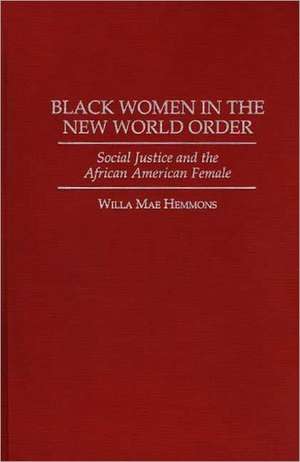Black Women in the New World Order: Social Justice and the African American Female
Autor Willa M. Hemmonsen Limba Engleză Hardback – 15 apr 1996 – vârsta până la 17 ani
Preț: 439.27 lei
Preț vechi: 605.04 lei
-27% Nou
Puncte Express: 659
Preț estimativ în valută:
84.13€ • 86.68$ • 70.47£
84.13€ • 86.68$ • 70.47£
Carte tipărită la comandă
Livrare economică 24 februarie-10 martie
Preluare comenzi: 021 569.72.76
Specificații
ISBN-13: 9780275952082
ISBN-10: 0275952088
Pagini: 304
Dimensiuni: 156 x 235 x 21 mm
Greutate: 0.6 kg
Editura: Bloomsbury Publishing
Colecția Praeger
Locul publicării:New York, United States
ISBN-10: 0275952088
Pagini: 304
Dimensiuni: 156 x 235 x 21 mm
Greutate: 0.6 kg
Editura: Bloomsbury Publishing
Colecția Praeger
Locul publicării:New York, United States
Notă biografică
Willa Mae Hemmons is a lawyer and sociologist. She received her PhD in Sociology from Case Western Reserve University and her JD from the University of Illinois School of Law. She is a practicing attorney in the areas of criminal law, domestic relations and contracts, and is also a professor in the Department of Social Work at Cleveland State University.
Cuprins
Black Women in the New World Order: An IntroductionBlack Women in the Political World OrderBlack Women in the Economic World OrderBlack Women in the World Order of EducationBlack Women in the World Order of Social WelfareBlack Women and the World's Ordering of "Family"Black Women in the World Order of HealthBlack Women as Ordered by the Criminal Justice WorldConclusionIndex
Recenzii
Hemmons offers a detailed, macro and micro examination of the mutually reciprocal functions and interdependent relationships of social institutions (politics, economy, education, social services, family, health, and criminal justice) detrimental to black women in the US under the 'New World Order.' She provides a view of the multidimension disadvantage, through institutionalized racism and sexism, that black women disproportionately face. The macro-level data is very insightful, especially when presented with comparative data for black men and white women and men. Other strengths include discussion of the often unacknowledged advantages that the privileged receive ('legacies' in colleges and universities, Social Security income, 'standardized' tests for educational placement) and the extensive use of court cases to illustrate how the status quo is maintained. . . . This book is disheartening because, Hemmons notes, as 'minorities' become more numerous in society and as the economy continues to be based on service occupations (i.e., low-pay, low-skill, part-time work with few benefits), the institutionalized suppression of black women will intensify.











